Enterprise Systems Report - BISY2005: Drivers, Contributions, Changes
VerifiedAdded on 2023/01/20
|14
|2844
|58
Report
AI Summary
This report delves into the realm of Enterprise Systems, analyzing the principal drivers behind their adoption by businesses, including market competition, operational cost reduction, consumer demands, technological advancements, societal pressures, and the pursuit of new business opportunities. The report then explores the significant contributions of Enterprise Systems to organizational performance, such as improved financial outcomes, enhanced organizational learning, increased customer satisfaction, and quicker product delivery, with a focus on how these contributions can be measured. Furthermore, the report identifies the major organizational changes essential for the successful implementation of Enterprise Systems, emphasizing the critical roles of management commitment and employee training. Through this comprehensive analysis, the report provides a detailed understanding of the multifaceted aspects of Enterprise Systems and their impact on business operations.

ENTERPRISE SYSTEMS 1
Enterprise Systems
Name:
Institution:
Course:
Tutor
Enterprise Systems
Name:
Institution:
Course:
Tutor
Paraphrase This Document
Need a fresh take? Get an instant paraphrase of this document with our AI Paraphraser
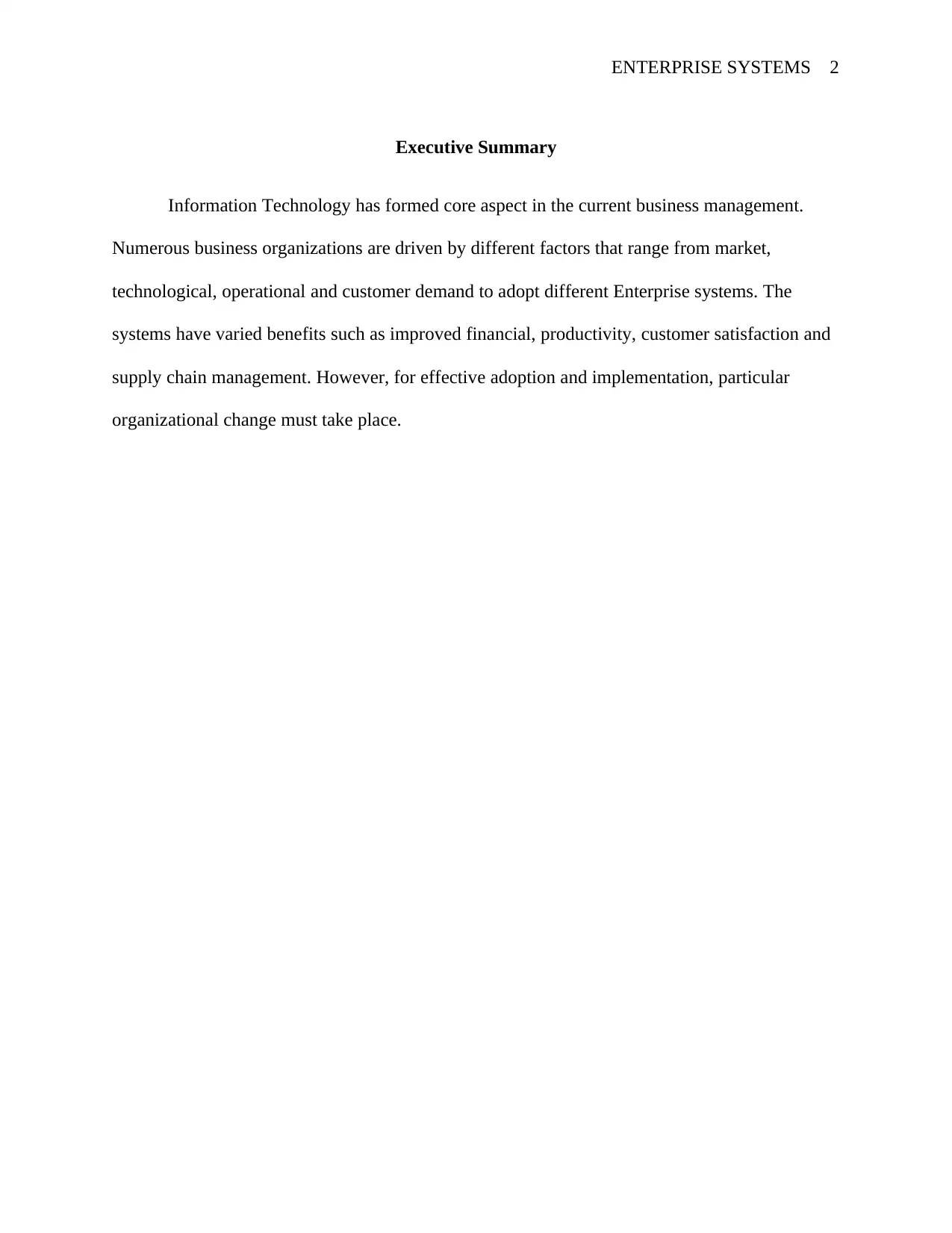
ENTERPRISE SYSTEMS 2
Executive Summary
Information Technology has formed core aspect in the current business management.
Numerous business organizations are driven by different factors that range from market,
technological, operational and customer demand to adopt different Enterprise systems. The
systems have varied benefits such as improved financial, productivity, customer satisfaction and
supply chain management. However, for effective adoption and implementation, particular
organizational change must take place.
Executive Summary
Information Technology has formed core aspect in the current business management.
Numerous business organizations are driven by different factors that range from market,
technological, operational and customer demand to adopt different Enterprise systems. The
systems have varied benefits such as improved financial, productivity, customer satisfaction and
supply chain management. However, for effective adoption and implementation, particular
organizational change must take place.
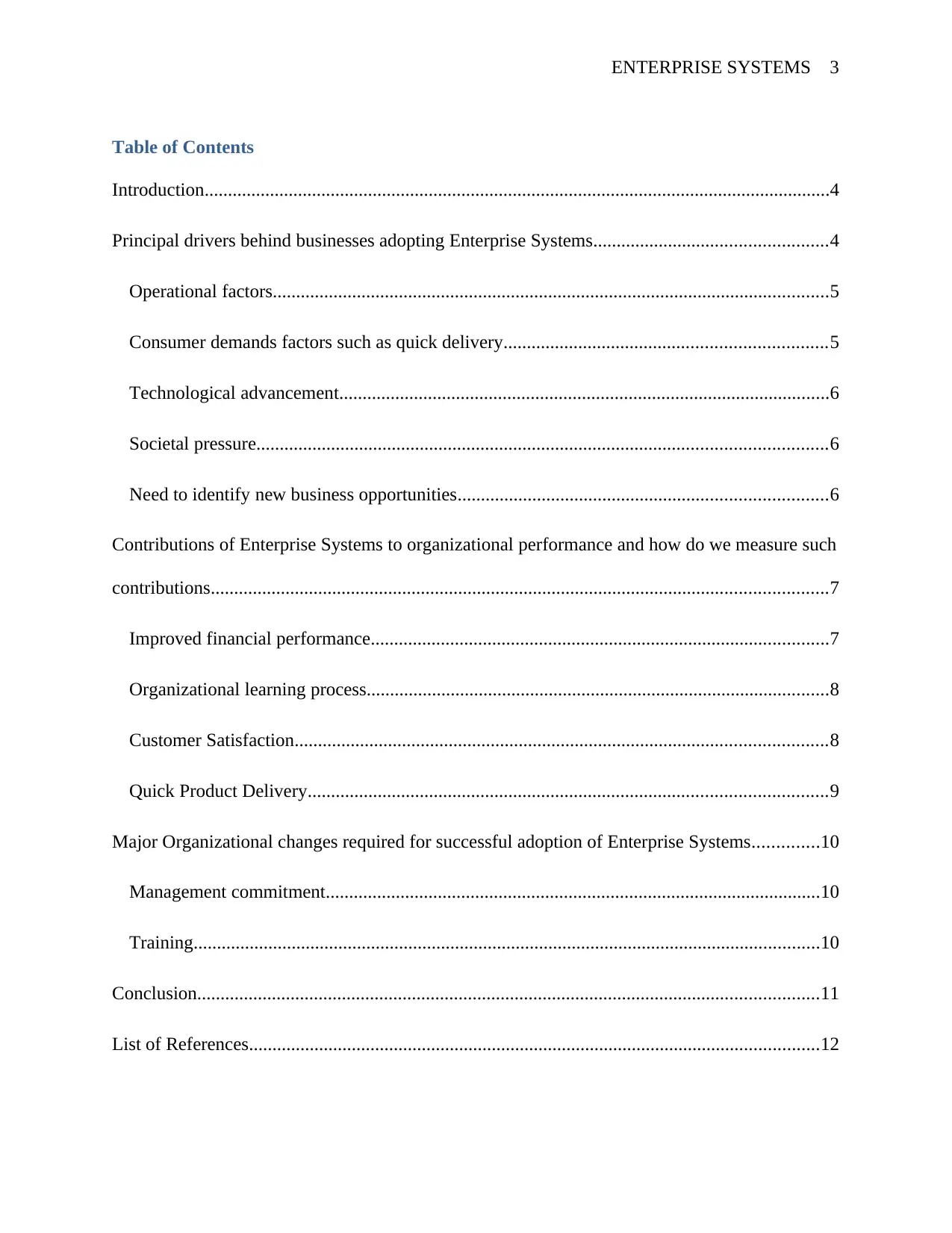
ENTERPRISE SYSTEMS 3
Table of Contents
Introduction......................................................................................................................................4
Principal drivers behind businesses adopting Enterprise Systems..................................................4
Operational factors.......................................................................................................................5
Consumer demands factors such as quick delivery.....................................................................5
Technological advancement.........................................................................................................6
Societal pressure..........................................................................................................................6
Need to identify new business opportunities...............................................................................6
Contributions of Enterprise Systems to organizational performance and how do we measure such
contributions....................................................................................................................................7
Improved financial performance..................................................................................................7
Organizational learning process...................................................................................................8
Customer Satisfaction..................................................................................................................8
Quick Product Delivery...............................................................................................................9
Major Organizational changes required for successful adoption of Enterprise Systems..............10
Management commitment..........................................................................................................10
Training......................................................................................................................................10
Conclusion.....................................................................................................................................11
List of References..........................................................................................................................12
Table of Contents
Introduction......................................................................................................................................4
Principal drivers behind businesses adopting Enterprise Systems..................................................4
Operational factors.......................................................................................................................5
Consumer demands factors such as quick delivery.....................................................................5
Technological advancement.........................................................................................................6
Societal pressure..........................................................................................................................6
Need to identify new business opportunities...............................................................................6
Contributions of Enterprise Systems to organizational performance and how do we measure such
contributions....................................................................................................................................7
Improved financial performance..................................................................................................7
Organizational learning process...................................................................................................8
Customer Satisfaction..................................................................................................................8
Quick Product Delivery...............................................................................................................9
Major Organizational changes required for successful adoption of Enterprise Systems..............10
Management commitment..........................................................................................................10
Training......................................................................................................................................10
Conclusion.....................................................................................................................................11
List of References..........................................................................................................................12
⊘ This is a preview!⊘
Do you want full access?
Subscribe today to unlock all pages.

Trusted by 1+ million students worldwide
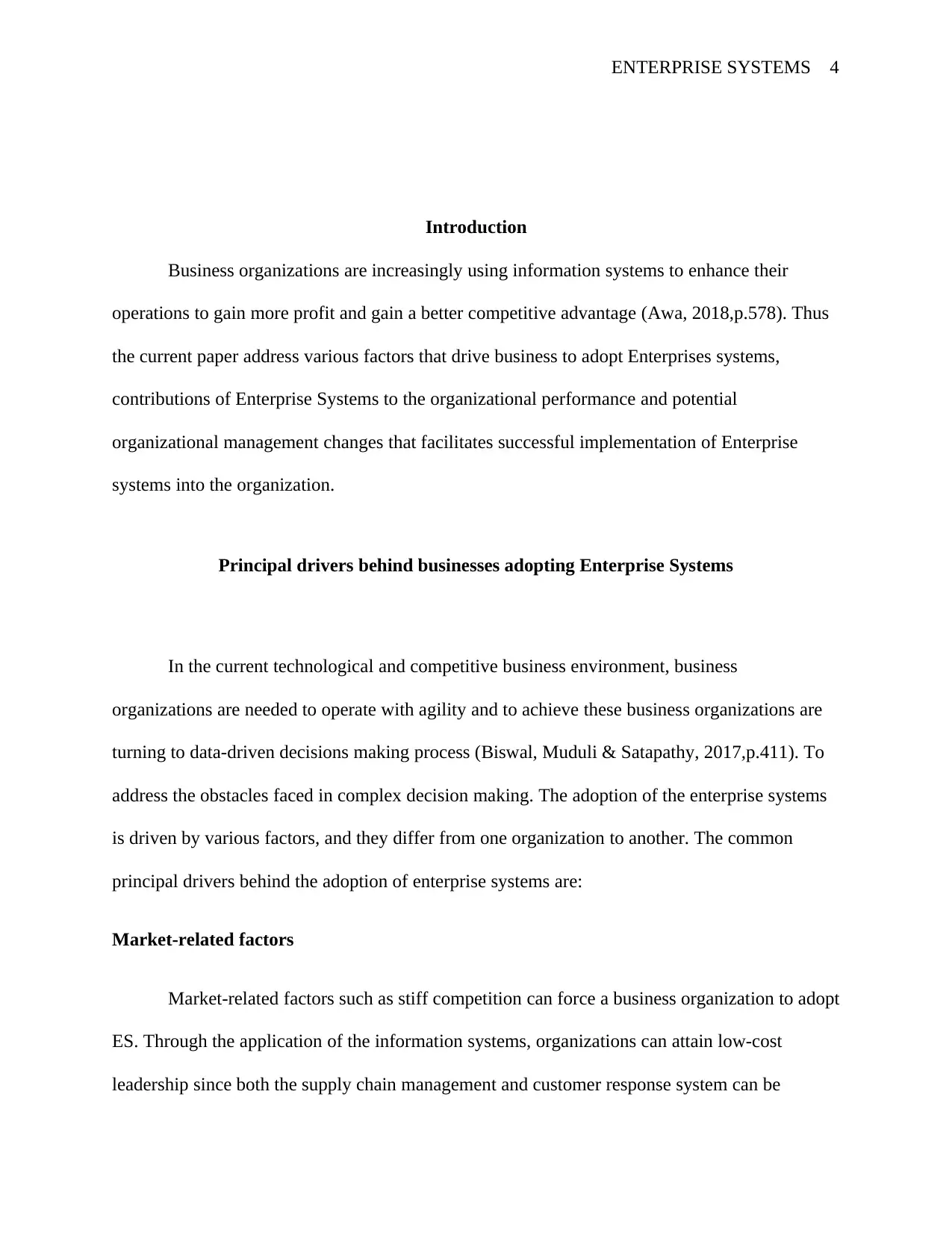
ENTERPRISE SYSTEMS 4
Introduction
Business organizations are increasingly using information systems to enhance their
operations to gain more profit and gain a better competitive advantage (Awa, 2018,p.578). Thus
the current paper address various factors that drive business to adopt Enterprises systems,
contributions of Enterprise Systems to the organizational performance and potential
organizational management changes that facilitates successful implementation of Enterprise
systems into the organization.
Principal drivers behind businesses adopting Enterprise Systems
In the current technological and competitive business environment, business
organizations are needed to operate with agility and to achieve these business organizations are
turning to data-driven decisions making process (Biswal, Muduli & Satapathy, 2017,p.411). To
address the obstacles faced in complex decision making. The adoption of the enterprise systems
is driven by various factors, and they differ from one organization to another. The common
principal drivers behind the adoption of enterprise systems are:
Market-related factors
Market-related factors such as stiff competition can force a business organization to adopt
ES. Through the application of the information systems, organizations can attain low-cost
leadership since both the supply chain management and customer response system can be
Introduction
Business organizations are increasingly using information systems to enhance their
operations to gain more profit and gain a better competitive advantage (Awa, 2018,p.578). Thus
the current paper address various factors that drive business to adopt Enterprises systems,
contributions of Enterprise Systems to the organizational performance and potential
organizational management changes that facilitates successful implementation of Enterprise
systems into the organization.
Principal drivers behind businesses adopting Enterprise Systems
In the current technological and competitive business environment, business
organizations are needed to operate with agility and to achieve these business organizations are
turning to data-driven decisions making process (Biswal, Muduli & Satapathy, 2017,p.411). To
address the obstacles faced in complex decision making. The adoption of the enterprise systems
is driven by various factors, and they differ from one organization to another. The common
principal drivers behind the adoption of enterprise systems are:
Market-related factors
Market-related factors such as stiff competition can force a business organization to adopt
ES. Through the application of the information systems, organizations can attain low-cost
leadership since both the supply chain management and customer response system can be
Paraphrase This Document
Need a fresh take? Get an instant paraphrase of this document with our AI Paraphraser
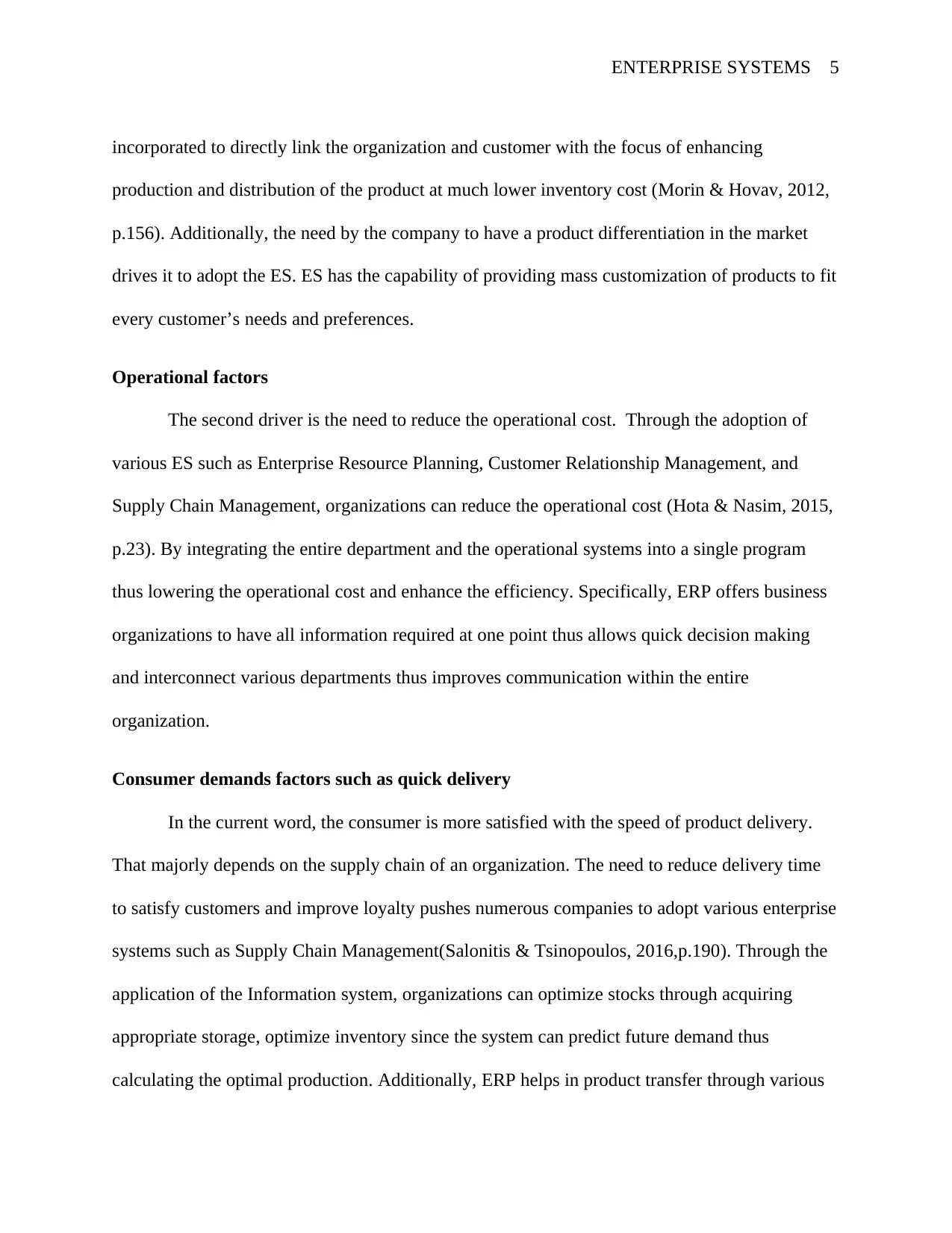
ENTERPRISE SYSTEMS 5
incorporated to directly link the organization and customer with the focus of enhancing
production and distribution of the product at much lower inventory cost (Morin & Hovav, 2012,
p.156). Additionally, the need by the company to have a product differentiation in the market
drives it to adopt the ES. ES has the capability of providing mass customization of products to fit
every customer’s needs and preferences.
Operational factors
The second driver is the need to reduce the operational cost. Through the adoption of
various ES such as Enterprise Resource Planning, Customer Relationship Management, and
Supply Chain Management, organizations can reduce the operational cost (Hota & Nasim, 2015,
p.23). By integrating the entire department and the operational systems into a single program
thus lowering the operational cost and enhance the efficiency. Specifically, ERP offers business
organizations to have all information required at one point thus allows quick decision making
and interconnect various departments thus improves communication within the entire
organization.
Consumer demands factors such as quick delivery
In the current word, the consumer is more satisfied with the speed of product delivery.
That majorly depends on the supply chain of an organization. The need to reduce delivery time
to satisfy customers and improve loyalty pushes numerous companies to adopt various enterprise
systems such as Supply Chain Management(Salonitis & Tsinopoulos, 2016,p.190). Through the
application of the Information system, organizations can optimize stocks through acquiring
appropriate storage, optimize inventory since the system can predict future demand thus
calculating the optimal production. Additionally, ERP helps in product transfer through various
incorporated to directly link the organization and customer with the focus of enhancing
production and distribution of the product at much lower inventory cost (Morin & Hovav, 2012,
p.156). Additionally, the need by the company to have a product differentiation in the market
drives it to adopt the ES. ES has the capability of providing mass customization of products to fit
every customer’s needs and preferences.
Operational factors
The second driver is the need to reduce the operational cost. Through the adoption of
various ES such as Enterprise Resource Planning, Customer Relationship Management, and
Supply Chain Management, organizations can reduce the operational cost (Hota & Nasim, 2015,
p.23). By integrating the entire department and the operational systems into a single program
thus lowering the operational cost and enhance the efficiency. Specifically, ERP offers business
organizations to have all information required at one point thus allows quick decision making
and interconnect various departments thus improves communication within the entire
organization.
Consumer demands factors such as quick delivery
In the current word, the consumer is more satisfied with the speed of product delivery.
That majorly depends on the supply chain of an organization. The need to reduce delivery time
to satisfy customers and improve loyalty pushes numerous companies to adopt various enterprise
systems such as Supply Chain Management(Salonitis & Tsinopoulos, 2016,p.190). Through the
application of the Information system, organizations can optimize stocks through acquiring
appropriate storage, optimize inventory since the system can predict future demand thus
calculating the optimal production. Additionally, ERP helps in product transfer through various
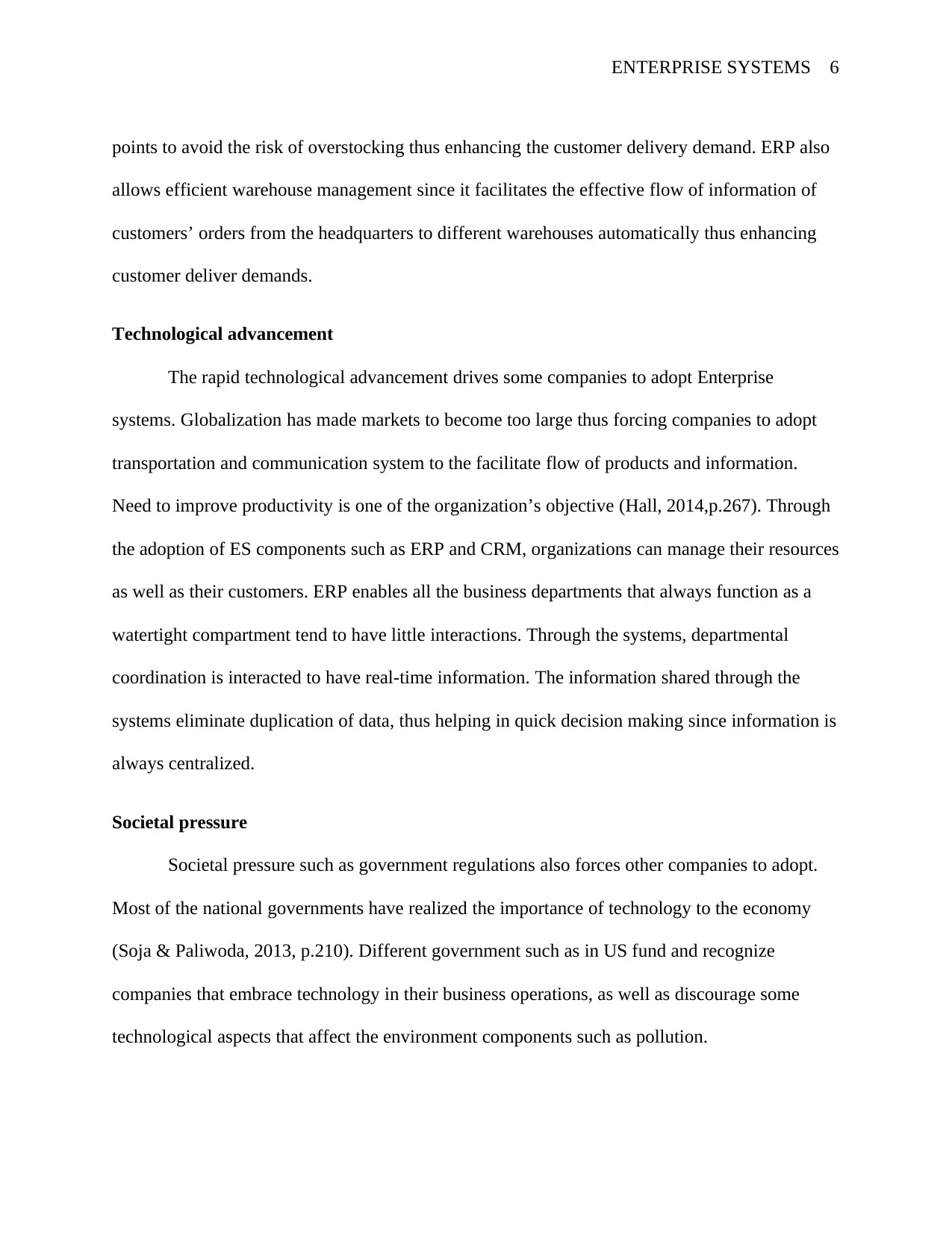
ENTERPRISE SYSTEMS 6
points to avoid the risk of overstocking thus enhancing the customer delivery demand. ERP also
allows efficient warehouse management since it facilitates the effective flow of information of
customers’ orders from the headquarters to different warehouses automatically thus enhancing
customer deliver demands.
Technological advancement
The rapid technological advancement drives some companies to adopt Enterprise
systems. Globalization has made markets to become too large thus forcing companies to adopt
transportation and communication system to the facilitate flow of products and information.
Need to improve productivity is one of the organization’s objective (Hall, 2014,p.267). Through
the adoption of ES components such as ERP and CRM, organizations can manage their resources
as well as their customers. ERP enables all the business departments that always function as a
watertight compartment tend to have little interactions. Through the systems, departmental
coordination is interacted to have real-time information. The information shared through the
systems eliminate duplication of data, thus helping in quick decision making since information is
always centralized.
Societal pressure
Societal pressure such as government regulations also forces other companies to adopt.
Most of the national governments have realized the importance of technology to the economy
(Soja & Paliwoda, 2013, p.210). Different government such as in US fund and recognize
companies that embrace technology in their business operations, as well as discourage some
technological aspects that affect the environment components such as pollution.
points to avoid the risk of overstocking thus enhancing the customer delivery demand. ERP also
allows efficient warehouse management since it facilitates the effective flow of information of
customers’ orders from the headquarters to different warehouses automatically thus enhancing
customer deliver demands.
Technological advancement
The rapid technological advancement drives some companies to adopt Enterprise
systems. Globalization has made markets to become too large thus forcing companies to adopt
transportation and communication system to the facilitate flow of products and information.
Need to improve productivity is one of the organization’s objective (Hall, 2014,p.267). Through
the adoption of ES components such as ERP and CRM, organizations can manage their resources
as well as their customers. ERP enables all the business departments that always function as a
watertight compartment tend to have little interactions. Through the systems, departmental
coordination is interacted to have real-time information. The information shared through the
systems eliminate duplication of data, thus helping in quick decision making since information is
always centralized.
Societal pressure
Societal pressure such as government regulations also forces other companies to adopt.
Most of the national governments have realized the importance of technology to the economy
(Soja & Paliwoda, 2013, p.210). Different government such as in US fund and recognize
companies that embrace technology in their business operations, as well as discourage some
technological aspects that affect the environment components such as pollution.
⊘ This is a preview!⊘
Do you want full access?
Subscribe today to unlock all pages.

Trusted by 1+ million students worldwide
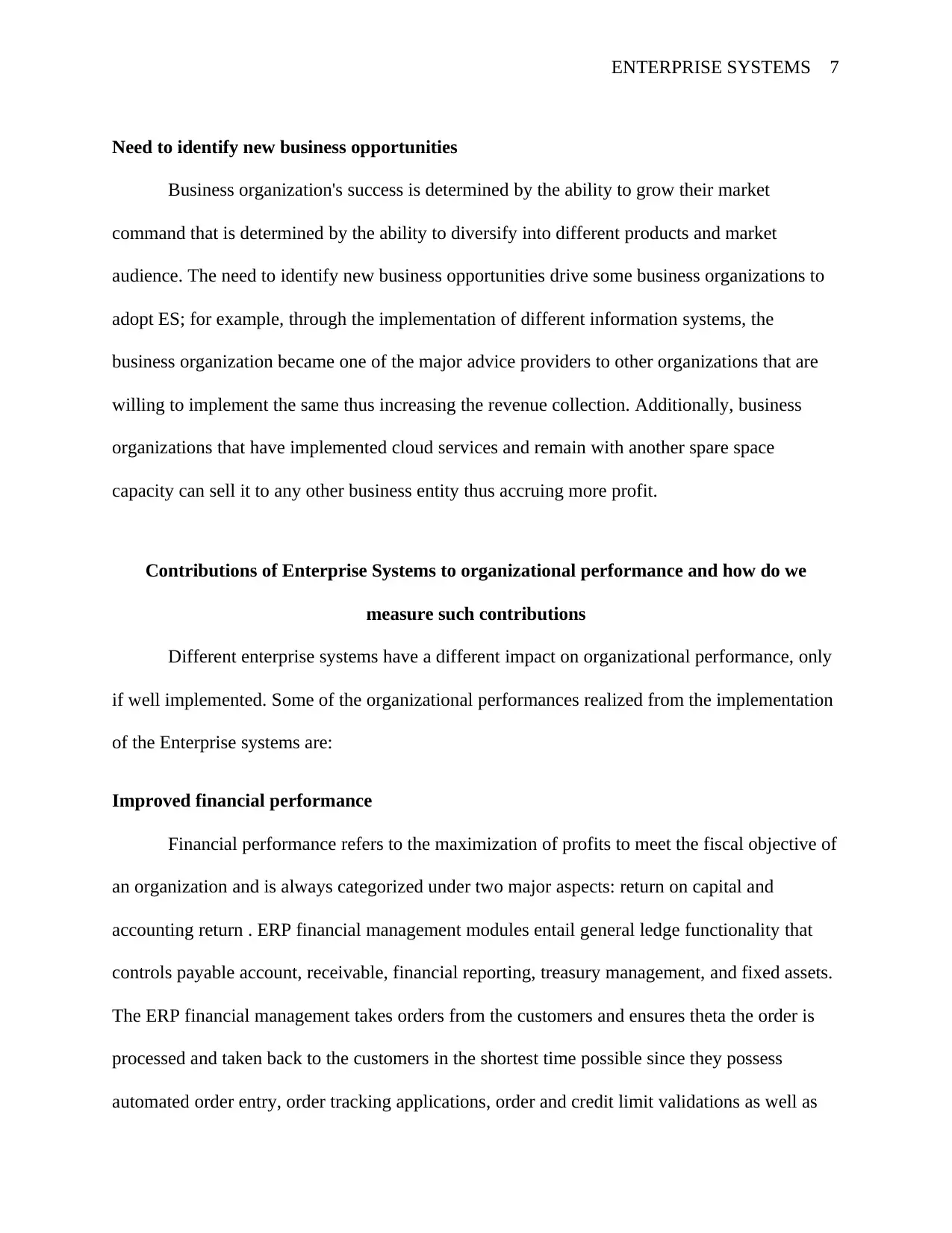
ENTERPRISE SYSTEMS 7
Need to identify new business opportunities
Business organization's success is determined by the ability to grow their market
command that is determined by the ability to diversify into different products and market
audience. The need to identify new business opportunities drive some business organizations to
adopt ES; for example, through the implementation of different information systems, the
business organization became one of the major advice providers to other organizations that are
willing to implement the same thus increasing the revenue collection. Additionally, business
organizations that have implemented cloud services and remain with another spare space
capacity can sell it to any other business entity thus accruing more profit.
Contributions of Enterprise Systems to organizational performance and how do we
measure such contributions
Different enterprise systems have a different impact on organizational performance, only
if well implemented. Some of the organizational performances realized from the implementation
of the Enterprise systems are:
Improved financial performance
Financial performance refers to the maximization of profits to meet the fiscal objective of
an organization and is always categorized under two major aspects: return on capital and
accounting return . ERP financial management modules entail general ledge functionality that
controls payable account, receivable, financial reporting, treasury management, and fixed assets.
The ERP financial management takes orders from the customers and ensures theta the order is
processed and taken back to the customers in the shortest time possible since they possess
automated order entry, order tracking applications, order and credit limit validations as well as
Need to identify new business opportunities
Business organization's success is determined by the ability to grow their market
command that is determined by the ability to diversify into different products and market
audience. The need to identify new business opportunities drive some business organizations to
adopt ES; for example, through the implementation of different information systems, the
business organization became one of the major advice providers to other organizations that are
willing to implement the same thus increasing the revenue collection. Additionally, business
organizations that have implemented cloud services and remain with another spare space
capacity can sell it to any other business entity thus accruing more profit.
Contributions of Enterprise Systems to organizational performance and how do we
measure such contributions
Different enterprise systems have a different impact on organizational performance, only
if well implemented. Some of the organizational performances realized from the implementation
of the Enterprise systems are:
Improved financial performance
Financial performance refers to the maximization of profits to meet the fiscal objective of
an organization and is always categorized under two major aspects: return on capital and
accounting return . ERP financial management modules entail general ledge functionality that
controls payable account, receivable, financial reporting, treasury management, and fixed assets.
The ERP financial management takes orders from the customers and ensures theta the order is
processed and taken back to the customers in the shortest time possible since they possess
automated order entry, order tracking applications, order and credit limit validations as well as
Paraphrase This Document
Need a fresh take? Get an instant paraphrase of this document with our AI Paraphraser
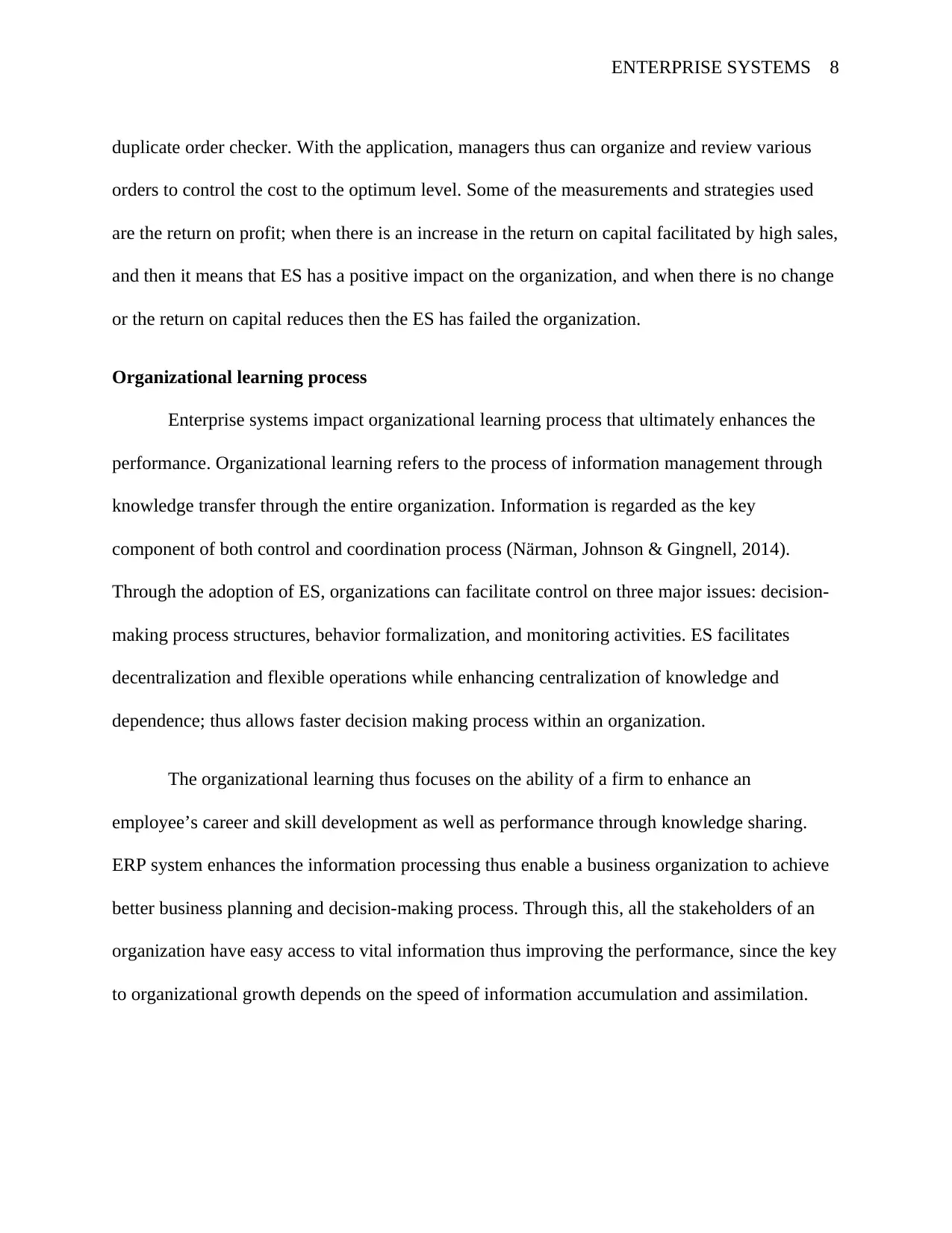
ENTERPRISE SYSTEMS 8
duplicate order checker. With the application, managers thus can organize and review various
orders to control the cost to the optimum level. Some of the measurements and strategies used
are the return on profit; when there is an increase in the return on capital facilitated by high sales,
and then it means that ES has a positive impact on the organization, and when there is no change
or the return on capital reduces then the ES has failed the organization.
Organizational learning process
Enterprise systems impact organizational learning process that ultimately enhances the
performance. Organizational learning refers to the process of information management through
knowledge transfer through the entire organization. Information is regarded as the key
component of both control and coordination process (Närman, Johnson & Gingnell, 2014).
Through the adoption of ES, organizations can facilitate control on three major issues: decision-
making process structures, behavior formalization, and monitoring activities. ES facilitates
decentralization and flexible operations while enhancing centralization of knowledge and
dependence; thus allows faster decision making process within an organization.
The organizational learning thus focuses on the ability of a firm to enhance an
employee’s career and skill development as well as performance through knowledge sharing.
ERP system enhances the information processing thus enable a business organization to achieve
better business planning and decision-making process. Through this, all the stakeholders of an
organization have easy access to vital information thus improving the performance, since the key
to organizational growth depends on the speed of information accumulation and assimilation.
duplicate order checker. With the application, managers thus can organize and review various
orders to control the cost to the optimum level. Some of the measurements and strategies used
are the return on profit; when there is an increase in the return on capital facilitated by high sales,
and then it means that ES has a positive impact on the organization, and when there is no change
or the return on capital reduces then the ES has failed the organization.
Organizational learning process
Enterprise systems impact organizational learning process that ultimately enhances the
performance. Organizational learning refers to the process of information management through
knowledge transfer through the entire organization. Information is regarded as the key
component of both control and coordination process (Närman, Johnson & Gingnell, 2014).
Through the adoption of ES, organizations can facilitate control on three major issues: decision-
making process structures, behavior formalization, and monitoring activities. ES facilitates
decentralization and flexible operations while enhancing centralization of knowledge and
dependence; thus allows faster decision making process within an organization.
The organizational learning thus focuses on the ability of a firm to enhance an
employee’s career and skill development as well as performance through knowledge sharing.
ERP system enhances the information processing thus enable a business organization to achieve
better business planning and decision-making process. Through this, all the stakeholders of an
organization have easy access to vital information thus improving the performance, since the key
to organizational growth depends on the speed of information accumulation and assimilation.
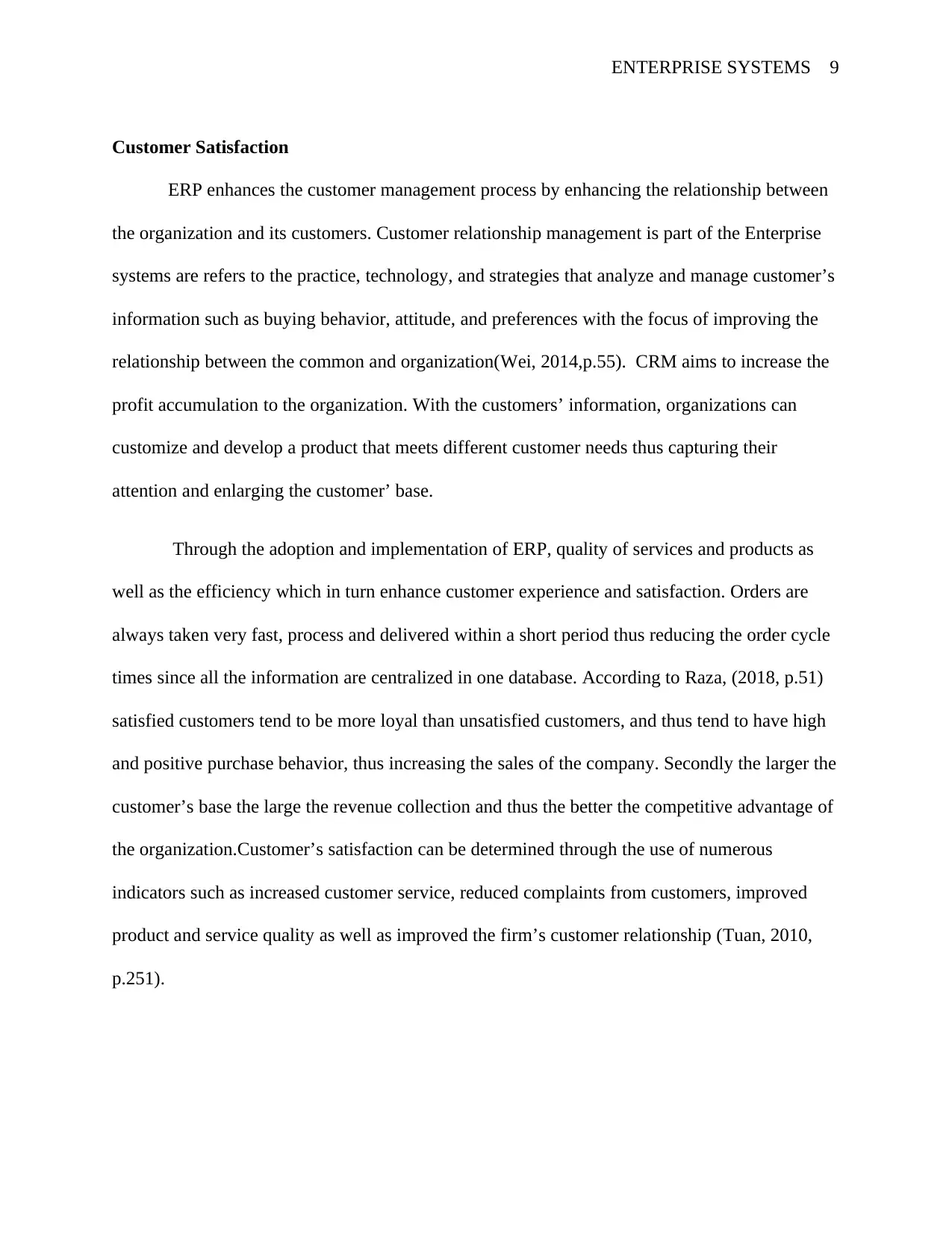
ENTERPRISE SYSTEMS 9
Customer Satisfaction
ERP enhances the customer management process by enhancing the relationship between
the organization and its customers. Customer relationship management is part of the Enterprise
systems are refers to the practice, technology, and strategies that analyze and manage customer’s
information such as buying behavior, attitude, and preferences with the focus of improving the
relationship between the common and organization(Wei, 2014,p.55). CRM aims to increase the
profit accumulation to the organization. With the customers’ information, organizations can
customize and develop a product that meets different customer needs thus capturing their
attention and enlarging the customer’ base.
Through the adoption and implementation of ERP, quality of services and products as
well as the efficiency which in turn enhance customer experience and satisfaction. Orders are
always taken very fast, process and delivered within a short period thus reducing the order cycle
times since all the information are centralized in one database. According to Raza, (2018, p.51)
satisfied customers tend to be more loyal than unsatisfied customers, and thus tend to have high
and positive purchase behavior, thus increasing the sales of the company. Secondly the larger the
customer’s base the large the revenue collection and thus the better the competitive advantage of
the organization.Customer’s satisfaction can be determined through the use of numerous
indicators such as increased customer service, reduced complaints from customers, improved
product and service quality as well as improved the firm’s customer relationship (Tuan, 2010,
p.251).
Customer Satisfaction
ERP enhances the customer management process by enhancing the relationship between
the organization and its customers. Customer relationship management is part of the Enterprise
systems are refers to the practice, technology, and strategies that analyze and manage customer’s
information such as buying behavior, attitude, and preferences with the focus of improving the
relationship between the common and organization(Wei, 2014,p.55). CRM aims to increase the
profit accumulation to the organization. With the customers’ information, organizations can
customize and develop a product that meets different customer needs thus capturing their
attention and enlarging the customer’ base.
Through the adoption and implementation of ERP, quality of services and products as
well as the efficiency which in turn enhance customer experience and satisfaction. Orders are
always taken very fast, process and delivered within a short period thus reducing the order cycle
times since all the information are centralized in one database. According to Raza, (2018, p.51)
satisfied customers tend to be more loyal than unsatisfied customers, and thus tend to have high
and positive purchase behavior, thus increasing the sales of the company. Secondly the larger the
customer’s base the large the revenue collection and thus the better the competitive advantage of
the organization.Customer’s satisfaction can be determined through the use of numerous
indicators such as increased customer service, reduced complaints from customers, improved
product and service quality as well as improved the firm’s customer relationship (Tuan, 2010,
p.251).
⊘ This is a preview!⊘
Do you want full access?
Subscribe today to unlock all pages.

Trusted by 1+ million students worldwide
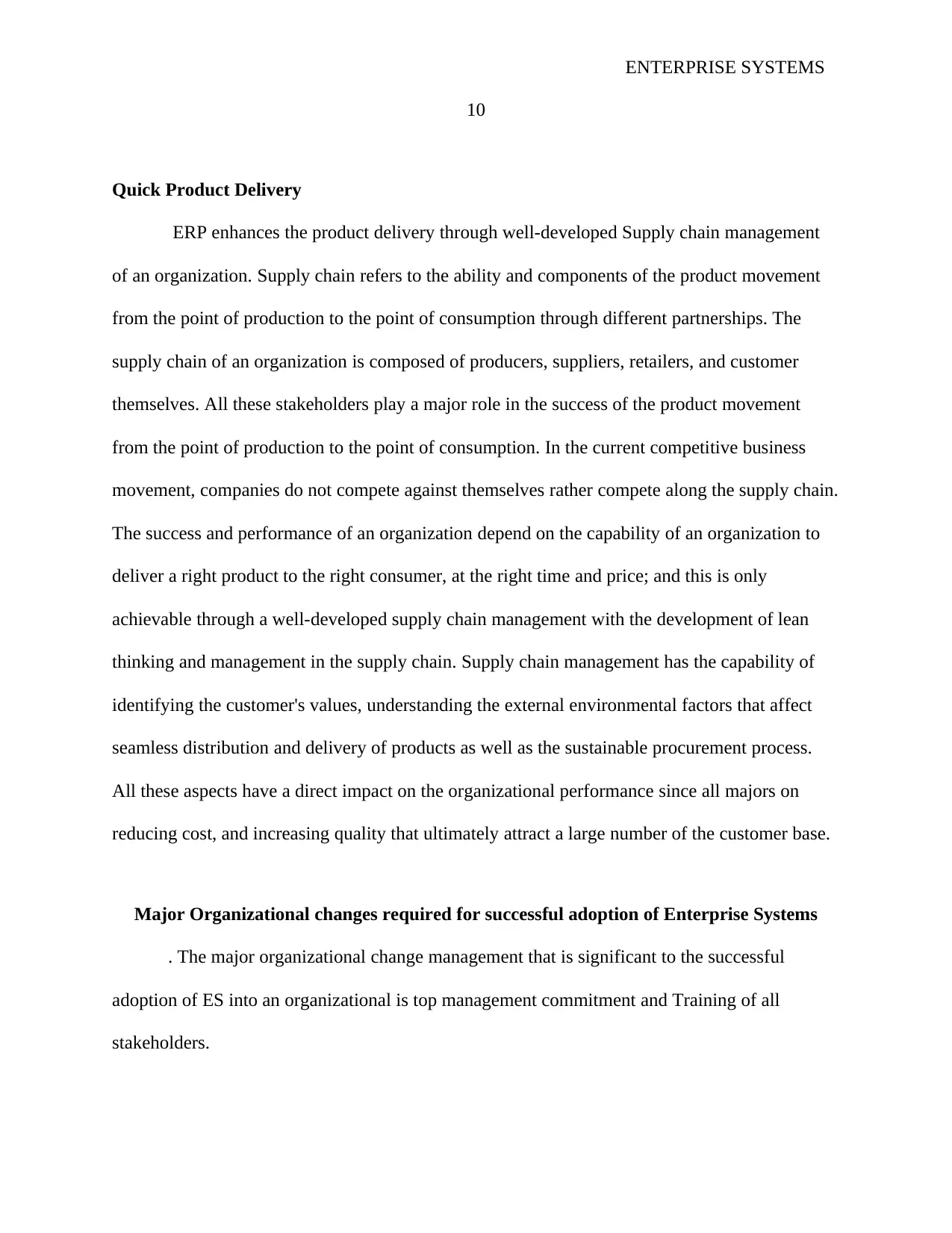
ENTERPRISE SYSTEMS
10
Quick Product Delivery
ERP enhances the product delivery through well-developed Supply chain management
of an organization. Supply chain refers to the ability and components of the product movement
from the point of production to the point of consumption through different partnerships. The
supply chain of an organization is composed of producers, suppliers, retailers, and customer
themselves. All these stakeholders play a major role in the success of the product movement
from the point of production to the point of consumption. In the current competitive business
movement, companies do not compete against themselves rather compete along the supply chain.
The success and performance of an organization depend on the capability of an organization to
deliver a right product to the right consumer, at the right time and price; and this is only
achievable through a well-developed supply chain management with the development of lean
thinking and management in the supply chain. Supply chain management has the capability of
identifying the customer's values, understanding the external environmental factors that affect
seamless distribution and delivery of products as well as the sustainable procurement process.
All these aspects have a direct impact on the organizational performance since all majors on
reducing cost, and increasing quality that ultimately attract a large number of the customer base.
Major Organizational changes required for successful adoption of Enterprise Systems
. The major organizational change management that is significant to the successful
adoption of ES into an organizational is top management commitment and Training of all
stakeholders.
10
Quick Product Delivery
ERP enhances the product delivery through well-developed Supply chain management
of an organization. Supply chain refers to the ability and components of the product movement
from the point of production to the point of consumption through different partnerships. The
supply chain of an organization is composed of producers, suppliers, retailers, and customer
themselves. All these stakeholders play a major role in the success of the product movement
from the point of production to the point of consumption. In the current competitive business
movement, companies do not compete against themselves rather compete along the supply chain.
The success and performance of an organization depend on the capability of an organization to
deliver a right product to the right consumer, at the right time and price; and this is only
achievable through a well-developed supply chain management with the development of lean
thinking and management in the supply chain. Supply chain management has the capability of
identifying the customer's values, understanding the external environmental factors that affect
seamless distribution and delivery of products as well as the sustainable procurement process.
All these aspects have a direct impact on the organizational performance since all majors on
reducing cost, and increasing quality that ultimately attract a large number of the customer base.
Major Organizational changes required for successful adoption of Enterprise Systems
. The major organizational change management that is significant to the successful
adoption of ES into an organizational is top management commitment and Training of all
stakeholders.
Paraphrase This Document
Need a fresh take? Get an instant paraphrase of this document with our AI Paraphraser
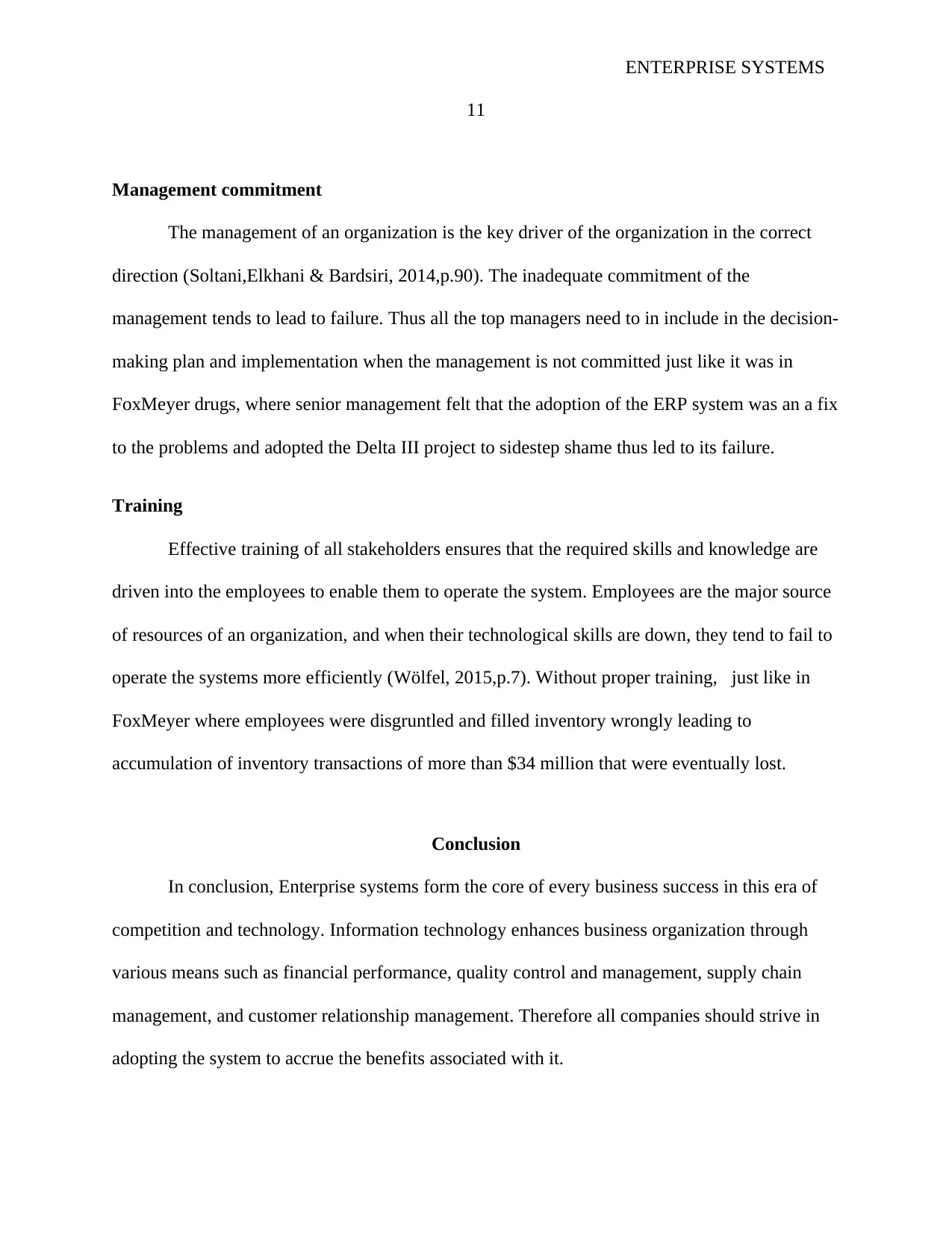
ENTERPRISE SYSTEMS
11
Management commitment
The management of an organization is the key driver of the organization in the correct
direction (Soltani,Elkhani & Bardsiri, 2014,p.90). The inadequate commitment of the
management tends to lead to failure. Thus all the top managers need to in include in the decision-
making plan and implementation when the management is not committed just like it was in
FoxMeyer drugs, where senior management felt that the adoption of the ERP system was an a fix
to the problems and adopted the Delta III project to sidestep shame thus led to its failure.
Training
Effective training of all stakeholders ensures that the required skills and knowledge are
driven into the employees to enable them to operate the system. Employees are the major source
of resources of an organization, and when their technological skills are down, they tend to fail to
operate the systems more efficiently (Wölfel, 2015,p.7). Without proper training, just like in
FoxMeyer where employees were disgruntled and filled inventory wrongly leading to
accumulation of inventory transactions of more than $34 million that were eventually lost.
Conclusion
In conclusion, Enterprise systems form the core of every business success in this era of
competition and technology. Information technology enhances business organization through
various means such as financial performance, quality control and management, supply chain
management, and customer relationship management. Therefore all companies should strive in
adopting the system to accrue the benefits associated with it.
11
Management commitment
The management of an organization is the key driver of the organization in the correct
direction (Soltani,Elkhani & Bardsiri, 2014,p.90). The inadequate commitment of the
management tends to lead to failure. Thus all the top managers need to in include in the decision-
making plan and implementation when the management is not committed just like it was in
FoxMeyer drugs, where senior management felt that the adoption of the ERP system was an a fix
to the problems and adopted the Delta III project to sidestep shame thus led to its failure.
Training
Effective training of all stakeholders ensures that the required skills and knowledge are
driven into the employees to enable them to operate the system. Employees are the major source
of resources of an organization, and when their technological skills are down, they tend to fail to
operate the systems more efficiently (Wölfel, 2015,p.7). Without proper training, just like in
FoxMeyer where employees were disgruntled and filled inventory wrongly leading to
accumulation of inventory transactions of more than $34 million that were eventually lost.
Conclusion
In conclusion, Enterprise systems form the core of every business success in this era of
competition and technology. Information technology enhances business organization through
various means such as financial performance, quality control and management, supply chain
management, and customer relationship management. Therefore all companies should strive in
adopting the system to accrue the benefits associated with it.
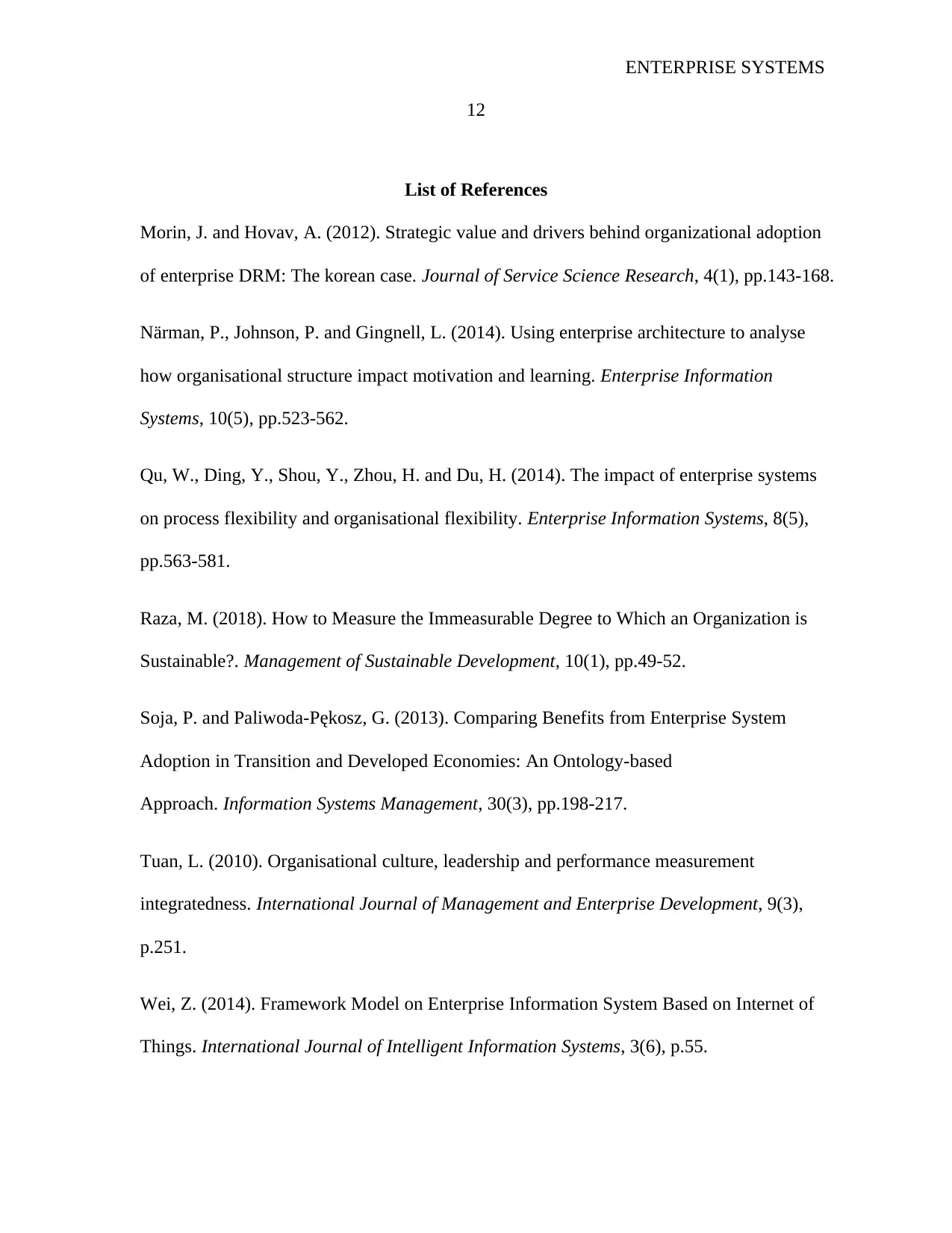
ENTERPRISE SYSTEMS
12
List of References
Morin, J. and Hovav, A. (2012). Strategic value and drivers behind organizational adoption
of enterprise DRM: The korean case. Journal of Service Science Research, 4(1), pp.143-168.
Närman, P., Johnson, P. and Gingnell, L. (2014). Using enterprise architecture to analyse
how organisational structure impact motivation and learning. Enterprise Information
Systems, 10(5), pp.523-562.
Qu, W., Ding, Y., Shou, Y., Zhou, H. and Du, H. (2014). The impact of enterprise systems
on process flexibility and organisational flexibility. Enterprise Information Systems, 8(5),
pp.563-581.
Raza, M. (2018). How to Measure the Immeasurable Degree to Which an Organization is
Sustainable?. Management of Sustainable Development, 10(1), pp.49-52.
Soja, P. and Paliwoda-Pękosz, G. (2013). Comparing Benefits from Enterprise System
Adoption in Transition and Developed Economies: An Ontology-based
Approach. Information Systems Management, 30(3), pp.198-217.
Tuan, L. (2010). Organisational culture, leadership and performance measurement
integratedness. International Journal of Management and Enterprise Development, 9(3),
p.251.
Wei, Z. (2014). Framework Model on Enterprise Information System Based on Internet of
Things. International Journal of Intelligent Information Systems, 3(6), p.55.
12
List of References
Morin, J. and Hovav, A. (2012). Strategic value and drivers behind organizational adoption
of enterprise DRM: The korean case. Journal of Service Science Research, 4(1), pp.143-168.
Närman, P., Johnson, P. and Gingnell, L. (2014). Using enterprise architecture to analyse
how organisational structure impact motivation and learning. Enterprise Information
Systems, 10(5), pp.523-562.
Qu, W., Ding, Y., Shou, Y., Zhou, H. and Du, H. (2014). The impact of enterprise systems
on process flexibility and organisational flexibility. Enterprise Information Systems, 8(5),
pp.563-581.
Raza, M. (2018). How to Measure the Immeasurable Degree to Which an Organization is
Sustainable?. Management of Sustainable Development, 10(1), pp.49-52.
Soja, P. and Paliwoda-Pękosz, G. (2013). Comparing Benefits from Enterprise System
Adoption in Transition and Developed Economies: An Ontology-based
Approach. Information Systems Management, 30(3), pp.198-217.
Tuan, L. (2010). Organisational culture, leadership and performance measurement
integratedness. International Journal of Management and Enterprise Development, 9(3),
p.251.
Wei, Z. (2014). Framework Model on Enterprise Information System Based on Internet of
Things. International Journal of Intelligent Information Systems, 3(6), p.55.
⊘ This is a preview!⊘
Do you want full access?
Subscribe today to unlock all pages.

Trusted by 1+ million students worldwide
1 out of 14
Related Documents
Your All-in-One AI-Powered Toolkit for Academic Success.
+13062052269
info@desklib.com
Available 24*7 on WhatsApp / Email
![[object Object]](/_next/static/media/star-bottom.7253800d.svg)
Unlock your academic potential
Copyright © 2020–2025 A2Z Services. All Rights Reserved. Developed and managed by ZUCOL.




